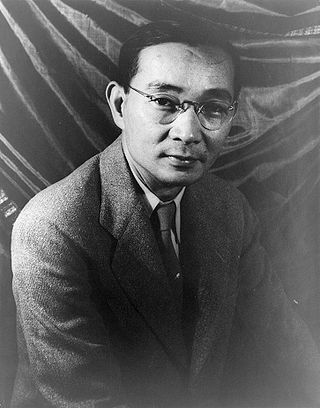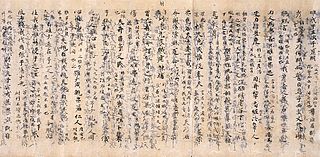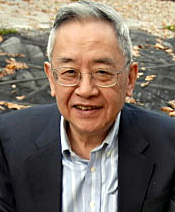Related Research Articles
The Chinese classics or canonical texts are the works of Chinese literature authored prior to the establishment of the imperial Qin dynasty in 221 BC. Prominent examples include the Four Books and Five Classics in the Neo-Confucian tradition, themselves an abridgment of the Thirteen Classics. The Chinese classics used a form of written Chinese consciously imitated by later authors, now known as Classical Chinese. A common Chinese word for "classic" literally means 'warp thread', in reference to the techniques by which works of this period were bound into volumes.

Lin Yutang was a Chinese inventor, linguist, novelist, philosopher, and translator. He had an informal style in both Chinese and English, and he made compilations and translations of the Chinese classics into English. Some of his writings criticized the racism and imperialism of the West.

The Book of Documents or the Classic of History, is one of the Five Classics of ancient Chinese literature. It is a collection of rhetorical prose attributed to figures of ancient China, and served as the foundation of Chinese political philosophy for over two millennia.

The Book of Han is a history of China finished in 111 CE, covering the Western, or Former Han dynasty from the first emperor in 206 BCE to the fall of Wang Mang in 23 CE. The work was composed by Ban Gu (32–92 CE), an Eastern Han court official, with the help of his sister Ban Zhao, continuing the work of their father, Ban Biao. They modelled their work on the Records of the Grand Historian, a cross-dynastic general history, but theirs was the first in this annals-biography form to cover a single dynasty. It is the best source, sometimes the only one, for many topics such as literature in this period. The Book of Han is also called the Book of the Former Han to distinguish it from the Book of the Later Han which covers the Eastern Han period (25–220 CE), and was composed in the fifth century by Fan Ye (398–445 CE).

The scholar-officials, also known as literati, scholar-gentlemen or scholar-bureaucrats, were government officials and prestigious scholars in Chinese society, forming a distinct social class.

The Siku Quanshu, literally the Complete Library of the Four Treasuries, is a Chinese encyclopedia commissioned during the Qing dynasty by the Qianlong Emperor. Commissioned in 1772 and completed in 1782, the Siku quanshu is the largest collection of books in imperial Chinese history, comprising 36,381 volumes, 79,337 manuscript rolls, 2.3 million pages, and about 997 million words. The complete encyclopedia contains an annotated catalogue of 10,680 titles along with a compendiums of 3,593 titles. The Siku Quanshu surpassed the 1403 Yongle Encyclopedia created by the previous Ming dynasty, which had been China's largest encyclopedia. Complete copies of the Siku Quanshu are held at the National Library of China in Beijing, the National Palace Museum in Taipei, the Gansu Library in Lanzhou, and the Zhejiang Library in Hangzhou.
Lothar Ledderose is a German professor of the History of Art of Eastern Asia at the University of Heidelberg. A renowned authority in his field, he received the prestigious Balzan Prize in 2005.
Sengzhao was a Chinese Buddhist philosopher from Later Qin. Born to a poor family in Jingzhao, he acquired literary skills, apparently including the capacity to read Pali, and became a scribe. This exposed him to a variety of uncommon documents. He was influenced by Taoists, Laozi and Zhuangzi, and although we are told he enjoyed Lao Tzu’s Daodejing, he was overjoyed when he discovered the Vimalakirti Sutra. This encounter transformed his life and he became a Buddhist. He was known as being among the ablest of the disciples of Kumārajīva.

Yu Ying-shih was a Chinese-born American historian, sinologist, and the Gordon Wu '58 Professor of Chinese Studies, Emeritus, at Princeton University. He was known for his mastery of sources for Chinese history and philosophy, his ability to synthesize them on a wide range of topics, and for his advocacy for a new Confucianism. He was a tenured professor at Harvard University and Yale University before his time at Princeton.

Arthur William Hummel Sr. was an American Christian missionary to China, head of the Asian Division of the Library of Congress, noted sinologist, and editor of Eminent Chinese of the Ch'ing Period, a biographical dictionary. He was the first president of the Association for Asian Studies, in 1948. Hummel's son, Arthur W. Hummel Jr., was a career diplomat and U.S. Ambassador to China.

David Richard Knechtges is an American sinologist and professor emeritus of Chinese literature at the University of Washington. An expert on Han dynasty and Six dynasties period literature, Knechtges' studies of Chinese fu poetry are largely responsible for the revival of Western academic interest in the subject, a major genre which had become largely neglected until the mid-20th century.
Frederick Wade "Fritz" Mote was an American sinologist and a professor of History at Princeton University for nearly 50 years. His research and teaching interests focused on China during the Yuan and Ming dynasties. In collaboration with Denis C. Twitchett and John K. Fairbank he helped create The Cambridge History of China, a monumental history of China.

Hsiung Shih-I was a writer, biographer, translator, academic, and playwright in Beijing and London. He was the first Chinese person to direct a West End play, and the founder of Tsing Hua Academy in Hong Kong.

Guan ju is the first poem from the ancient anthology Shi Jing, and is one of the best known poems in Chinese literature. It has been dated to the seventh century BC, making it also one of China's oldest poems, though not the oldest in the Shi Jing. The title of the poem comes from its first line, which evokes a scene of ospreys calling on a river islet. Fundamentally the poem is about finding a good and fair maiden as a match for a young noble.
Homer Hasenpflug Dubs was an American sinologist. Though best known for his translation of sections of Ban Gu's Book of Han, he published on a wide range of topics in ancient Chinese history, astronomy and philosophy. Raised in China as the son of missionaries, he returned to the United States and earned a Ph.D. in philosophy (1925). He taught at University of Minnesota and Marshall College before undertaking the Han shu translation project at the behest of the American Council of Learned Societies. Subsequently, Dubs taught at Duke University, Columbia University and Hartford Seminary. In 1947, Dubs moved to England to take up the Chair of Chinese at Oxford University, which had been vacant since 1935. He retired in 1959 and remained in Oxford until his death in 1969.

Frances Wood is an English librarian, sinologue and historian known for her writings on Chinese history, including Marco Polo, life in the Chinese treaty ports, and the First Emperor of China.

Yang Lien-sheng who often wrote under the name L.S. Yang, was a Chinese-American sinologist and professor at Harvard University. He was the first full-time historian of China at Harvard and a prolific scholar specializing in China's economic history.

Kang-i Sun Chang is a Taiwanese American sinologist. She is a scholar of classical Chinese literature. She is the inaugural Malcolm G. Chace Professor, and former chair of the Department of East Asian Languages and Literatures at Yale University.
The East Asian Library and the Gest Collection in the Princeton University Library is the university's principle collection of materials in Chinese, Japanese, and Korean languages, as well as works on Chinese, Japanese and Korean linguistics and literatures in Western languages.
Lu Shi'e was a Chinese writer who previously worked as a doctor. His hometown was southwest of Shanghai. He wrote fanxin xiaoshuo works.
References
- Hu, Shih (Spring 1954), "The Gest Oriental Library at Princeton University", The Princeton University Library Chronicle, 15 (3): 113–141, doi: 10.2307/26406952 , JSTOR 26406952 reprinted in: Chou, Chih-p'ing, ed. (2013). "The Gest Oriental Library at Princeton University". English Writings of Hu Shih. China Academic Library. Springer Berlin Heidelberg. pp. 177–196. doi:10.1007/978-3-642-31184-0_26. ISBN 978-3-642-31183-3.
- Perushek, Diane E. (1985). "Nancy Lee Swann and the Gest Chinese Research Library". Journal of East Asian Libraries. 1985 (77): 5.
- Brooks, E Bruce (2008), "Nancy Lee Swann (1881 - 1966)", Sinological Profiles, University of Massachusetts, Amherst